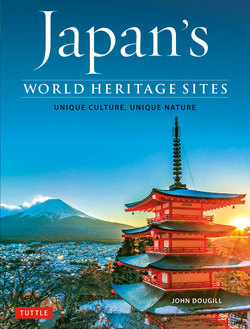Читать книгу Japan's World Heritage Sites - John Dougill - Страница 16
На сайте Литреса книга снята с продажи.
ОглавлениеRYOAN-JI
JAPAN’S ICONIC ZEN ROCK GARDEN
RYOAN-JI AT A GLANCE
FEATURES A Zen temple with dry landscape and pond gardens.
ACCESS From JR Kyoto stn, bus 101 or 205 (40 mins) or 20 mins walk from Kinkaku-ji.
PRACTICALITIES 8.00–17.00 (8.30–16.30 Dec–Feb). ¥500. Temple tel. (075) 463-2216. Allow around 90 mins. Best to visit early morning or late afternoon.
DATELINE
1450—Founded as a private estate
1473—Conversion to a Zen temple late
1400s—Creation of rock garden
1800—Temple rebuilt after fire
Ryoan-ji is synonymous with its rock garden although there’s more than just that. It started life as an aristocratic estate with a large pond set beneath the northern hills. Later, the estate was converted into a Zen temple, and the rock garden was added around 1500, possibly by master designer Soami. Fire laid waste to the temple in 1797, following which it took its present form.
The route leads straight to the Hojo Hall (Abbot’s Quarters), the veranda of which overlooks the famous rock garden. It contains nothing but white gravel and fifteen rocks, bordered by a yellowish clay wall. Various theories have been put forward to explain it: mountain peaks protruding from cloud, islands in a cosmic ocean, a Chinese riddle about tiger cubs.
Ryoan-ji’s water basin, donated in the seventeenth century, is shaped as a coin but bears an inscription that implies learning should be for its own sake, not for profit.
It’s thought the rock garden was originally open-sided, and that the earthen wall made of clay boiled in oil was a later addition.
Visitors sit in contemplation of the temple’s famous rock garden, with their backs to the Hojo Hall Abbot’s Quarters. Intriguingly, not all the fifteen rocks can be seen at one time.
The sand base of the garden is raked daily in a set pattern. The only greenery in the garden is the moss around the base of the stones.
The contrasting shapes of the rocks suggest yin–yang significance, while the groupings of seven, five and three are important numbers for Taoism. The key factor, however, could be that not all fifteen rocks can be seen at once. The fifteenth day in the lunar calendar signifies completion, with the implication being that ‘the complete picture’ can never be seen.
Inside the Hojo Hall is a set of six rooms with sliding screen (fusuma) paintings, and at the rear is a replica of the temple’s famous water basin in which the central square represents the kanji for ‘mouth’. The slogan it bears can be read to mean that learning should be for its own sake. At the same time, the water has a symbolic purpose, for it purifies the soul as well as washing the hands, and the overall effect is of a witty statement against materialism.
From the rock garden a path leads through a wooded area with an attractive moss ground covering.
On the way back to the entrance, the pathway leads through moss-covered grounds and around the large pond with its hilly backdrop. Because of the popularity of the rock garden, there is little peace there for contemplation, but here in the spacious surrounds there comes a chance to pause for thought. Just fifteen rocks—but what a powerful impact!
Steps lead up to the Priests’ Quarters, where a corridor leads off to the rock garden and the adjacent Abbot’s Quarters.
The temple’s pond garden was created in the twelfth century and has two islands, on one of which is a small Benten shrine where one can pray for good fortune.
